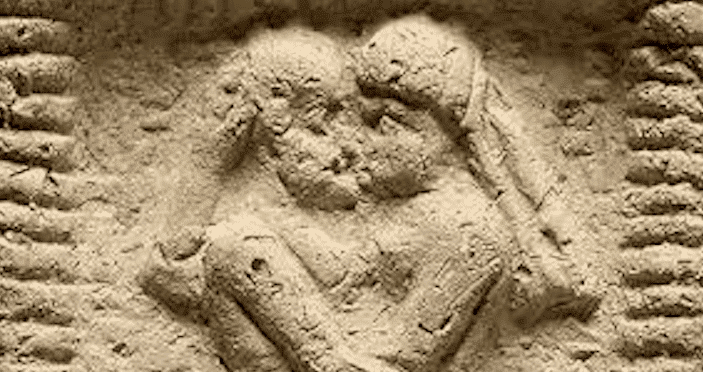Sources from Mesopotamia contextualize the emergence of kissing and its role in disease transmission
By TROELS PANK ARBØLL AND SOPHIE LUND RASMUSSEN
Recent studies maintain that the first known record of human romantic-sexual kissing originates in a Bronze Age manuscript deriving from South Asia (India), tentatively dated to 1500 BCE (1). Yet, a substantial corpus of overlooked evidence challenges this premise because lip kissing was documented in ancient Mesopotamia and Egypt from at least 2500 BCE onward. Because this behavior did not emerge abruptly or in a specific society but appears to have been practiced in multiple ancient cultures over several millennia, the kiss cannot be regarded as a sudden biological trigger causing a spread of specific pathogens, as recently proposed (2). Further understanding of the history of kissing in human societies—and its secondary effect on disease transmission—can be gained from a case study of sources from ancient Mesopotamia (modern-day Iraq and Syria).
In research, two types of kissing are generally differentiated, namely the friendly-parental kiss and the romantic-sexual kiss. Whereas friendly-parental kissing appears to be ubiquitous among humans across time and geography, romantic-sexual kissing is not culturally universal, and it is dominant in stratified societies (3). Research has suggested that romantic-sexual kissing evolved for the purposes of evaluating aspects of a potential mate’s suitability through chemical cues communicated in the saliva or breath, mediating feelings of attachment between pairbonded individuals, and facilitating sexual arousal and thereby sexual relations (3). Kissing is also attested in other animal species, such as mouth-to-mouth kissing with a romantic-sexual purpose in bonobos (Pan paniscus) and platonic kissing to manage social relationships in chimpanzees (Pan troglodytes) (1). These two species constitute the closest living relatives to humans, and their practices of kissing may hint at the presence and evolution of this behavior in human ancestors (4).
In a study investigating the transfer of the oral microbe Methanobrevibacter oralis, it has been hypothesized that Neanderthals could have engaged in lip kissing with modern humans more than 100,000 years ago (5, 6). Still, the advent of romantic-sexual kissing remains uncertain, although two prehistoric sculptures from Ain Sakhri (BM 1958,1007.1) and Malta (T/p1014) might imply its existence before the invention of writing.
Humanity’s earliest recorded kiss occurs in sources from the ancient Middle East. Kissing is attested in ancient Mesopotamian texts from 2500 BCE onward. Ancient Mesopotamia constituted the areas along the Euphrates and Tigris rivers, which today roughly cover Iraq and Syria. Writing was first invented simultaneously in southern Iraq and in Egypt around 3200 BCE. In Mesopotamia people wrote in cuneiform script on clay tablets, which primarily recorded the Sumerian and Akkadian languages from ∼3200 BCE to 75 CE. In the earliest texts in the Sumerian language, kissing was described in relation to erotic acts, possibly as a postcoital activity, and the locus was the lips (7). In the Akkadian language, references to kissing can be subdivided into two distinct groups, the first designating friendly and familial affection, describing a display of submission or respect through the act of kissing the feet or the ground, and the second being an erotic action with the lips as the primary locus (7).
Considering the thousands of cuneiform texts that are available, there are relatively few instances where romantic-sexual kissing is described. Regardless, there are clear examples illustrating that kissing was considered an ordinary part of romantic intimacy in ancient times. The texts imply that kissing was something that married couples did (8), though the kiss was regarded as part of an unmarried person’s sexual desire when in love (8). Two texts from ∼1800 BCE are especially revealing. One describes how a married woman was almost led astray by a kiss from another man, and the other describes an unmarried woman swearing to avoid kissing and having sexual relations with a specific man (9). Apparently, society tried to regulate such activities between unwed people or adulterers. Furthermore, the sexual aspect of kissing was frowned upon in public, and kissing a person who was not meant to be sexually active, such as a priestess, was believed to deprive the kisser of the ability to speak (9). Still, it seems that tokens of friendship and familial affection, such as that between mother and child, included kissing (7). Kissing was also used in ritual contexts, where a person in need of divine restoration could kiss a person in a state of trance, an old woman, or a slave girl.
Reaching beyond its importance for social and sexual behavior, the act of kissing may have played a secondary and unintentional role throughout history in facilitating the transfer of orally transmitted microorganisms, potentially causing disease. Infectious diseases have been around since the dawn of history, with a constant evolutionary arms race unfolding between pathogens and hosts. Recent advances in the technology for extracting ancient DNA have enabled the detection of a wide range of pathogen genomes, such as herpes simplex virus 1 (HSV-1) (2), Epstein-Barr virus (10), and human parvovirus B19 (11), in ancient human remains. These pathogens can infect humans through a range of different transmission routes, including saliva, making any act of kissing a potential means of spreading infection (12). The confirmation of microbial genomes deriving from human remains dating back thousands of years indicates that potentially kiss-transmissible organisms were present in historical and even prehistorical periods (5).
Recently, an interesting study presented ancient European human HSV-1 genomes deriving from dental material from human skeletons dating from 253 to 1700 CE (2). The authors discovered that there was a shift in dominant lineages of HSV-1 in the Bronze Age, and they suggested that this shift occurred because of an additional route of lateral transmission of HSV-1, potentially linked to the introduction of new cultural practices caused by migration, such as romantic-sexual kissing. Given this example, it is possible that symptoms indicating HSV-1 were included in the substantial corpus of medical manuscripts that describe symptoms of illness from ancient Mesopotamia. Although this material should be cautiously approached when using retrospective diagnosis, which interprets ancient descriptions of a specific illness by correlating the symptoms with those of a modern disease, it cannot be ignored that the ancient medical texts were influenced by a variety of cultural and religious concepts. It must therefore be emphasized that the preserved texts cannot be read at face value.
It has been proposed that the disease called bu’šānu, which was described in ancient medical texts, might have reflected HSV-1 infection (10) in addition to a number of other modern diseases, such as diphtheria. The bu’šānu, disease was located primarily in or around the mouth and pharynx, and the name itself was derived from a verb meaning “to stink” (13). Various descriptions of the disease exist, and several include the symptom bubu’tu (14). The interpretation that bušānu could cover HSV-1 infection is mainly based on the observation that bubu’tu might be interpreted as “vesicle,” although the translations “pustule” and “boil” remain dominant. Vesicles in or around the mouth are one of the dominant signs of HSV-1 infection.
Ideas of how humans contracted disease in ancient Mesopotamia differed from the modern understanding (15), and people in Mesopotamia did not attribute bušānu, or the spread of infectious diseases in general, to kissing. Regardless, certain cultural and religious factors instituted a partial social control on this practice. Such regulation of intimate relations could have had the unrecognized benefit of reducing the spread of pathogens. Still, it seems that experience with contagious illness may have brought about other pragmatic means to avoid infection through bodily fluids. In a letter from ∼1775 BCE, a woman in a palace harem had fallen ill with an infectious disease that caused lesions (9). To avert infection, everyone was instructed to avoid drinking from her cup, sleeping in her bed, or sitting on her chair.
The sources from ancient Mesopotamia suggest that kissing in relation to sex, family, and friendship was an ordinary part of everyday life in central parts of the ancient Middle East from the late 3rd millennium BCE onward. Accordingly, kissing should not be regarded as a custom originating exclusively in any single region and spreading from there (7). Furthermore, the sources from Mesopotamia show that the romantic-sexual kiss was known far earlier, and in a wider geographic area, than the references from India dated to 1500 BCE (1, 2), which stands in contrast to previous observations about the history of kissing (2).
Accounting for an ancient cultural diffusion of the romantic-sexual kiss is challenging, and it seems to have had numerous independent origins. Although some societies may not have practiced the romantic-sexual kiss, it must have been known in most ancient cultures, which could be indicative of a near universality. The written documentation to support this observation originates in stratified and complex societies, and the question remains whether the findings are only typical of behaviors found in complex state-level societies. Evidence indicates that kissing was a common practice in ancient times, potentially representing a constant influence on the spread of orally transmitted microbes, such as HSV-1. It therefore seems unlikely that kissing would have arisen as an immediate behavioral adaptation in other contemporary societies, which inadvertently accelerated disease transmission. Finally, the debate about kissing as a vector of disease transmission illustrates the benefits of an interdisciplinary approach to produce a holistic representation of historical disease transmission through social interactions.
Acknowledgments
The authors acknowledge financial support from the Carlsberg Foundation and the Edubba Foundation.

